SDG13: CLIMATE ACTION
Sustainable Development Goal 13 (SDG 13) calls for urgent action to combat climate change and its impacts. As the global community faces the escalating challenges of climate change, various nations are working towards mitigating its effects. This essay focuses on Saudi Arabia's efforts to address climate change, with a special emphasis on Qassim University's role in promoting climate action.
Climate Action in Saudi Arabia:
Saudi Arabia, a nation known for its rich oil reserves, has recognized the critical importance of addressing climate change. The country's Vision 2030 plan reflects its commitment to diversifying its economy, reducing its dependency on fossil fuels, and mitigating greenhouse gas emissions. The Saudi government has initiated several measures to combat climate change:
- Renewable Energy Investments: Saudi Arabia has invested significantly in renewable energy sources like solar and wind power. The country aims to generate 50% of its electricity from renewables by 2030, a significant step towards reducing its carbon footprint.
- Carbon Pricing: The nation has introduced a carbon pricing mechanism to encourage industries to reduce emissions and adopt cleaner technologies.
- Reforestation Efforts: Large-scale reforestation projects have been launched to increase the country's green cover and absorb carbon dioxide from the atmosphere.
- Energy Efficiency: The government is implementing energy efficiency programs across various sectors to reduce energy consumption and associated emissions.
Qassim University's Climate Action Initiatives:
Qassim University, a prominent educational institution in Saudi Arabia, recognizes its responsibility to contribute to climate action. The university has taken several proactive measures to address climate change and promote sustainability:
- Research and Innovation: Qassim University has established research centers and initiatives focused on environmental sustainability and climate change. These centers conduct cutting-edge research on renewable energy, carbon capture, sustainable agriculture, and other relevant areas.
- Curriculum Integration: The university has integrated climate-related topics into its academic curriculum across disciplines. This ensures that students are educated about the science of climate change, its impacts, and potential solutions.
- Awareness Campaigns: Qassim University conducts awareness campaigns and workshops to educate its students, faculty, and the local community about the importance of climate action. These campaigns promote sustainable practices and encourage behavioral changes.
- Renewable Energy Adoption: The university has invested in on-campus renewable energy projects, such as solar panels and wind turbines, to reduce its carbon footprint and serve as a model for sustainable energy practices.
- Collaboration and Partnerships: Qassim University collaborates with governmental bodies, non-governmental organizations, and industry partners to collectively address climate change challenges. This collaboration enhances the impact of climate action initiatives.
Challenges and Future Prospects:
While Saudi Arabia and Qassim University have made commendable efforts in climate action, challenges remain. These include transitioning from fossil fuel dependency, ensuring policy implementation, and fostering a culture of sustainability. However, with a strong commitment and ongoing initiatives, both the nation and the university are poised to make significant strides in climate action.
Climate change is a global crisis that demands immediate and concerted efforts. Saudi Arabia's commitment to SDG 13 and Qassim University's proactive approach in promoting climate action exemplify the role that nations and educational institutions can play in mitigating climate change. By addressing climate challenges collectively, societies can work towards a sustainable and resilient future for generations to come.
Research for Health Innovation:
The university's commitment to SDG 3 extends to its research efforts focused on health innovation and improvement. Qassim University's research projects address critical health issues, such as infectious diseases, chronic conditions, and healthcare delivery. By generating knowledge and innovative solutions, the university contributes to advancements in medical practices and patient care.
The University Receives a Delegation from the Ministry of Environment, Water and Agriculture
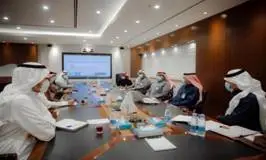

The University, represented by the Faculty of Agriculture and Veterinary Medicine, received on Wednesday, 7/6/1442 AH, a delegation from the Ministry of Environment, Water and Agriculture, where the two parties held the second meeting to activate the memorandum of understanding between them to discuss cooperation in the fields of environmental conservation, and then the delegation toured a number of colleges at the headquarters of the University City, including the Faculty of Agriculture and Veterinary Medicine, the College of Engineering, the Faculty of Science, and the Faculty of Economics and Management.
This meeting comes as an activation of the memorandum of understanding signed between the University and the Ministry of Environment, Water and Agriculture to cooperate in the fields of the environment in an effort to benefit each party from the capabilities and expertise of the other party, where the meeting discussed the tasks of the members of the two teams, and the efforts exerted by each party in the field of awareness of the need to preserve the environment and increase green spaces and ways to achieve integration between them for the benefit of all society.
They also discussed the needs of the two sides and how to exchange experiences between them in the field of academic and training programs, whether at the level of intermediate and high diplomas, or undergraduate and graduate programs, where the university team participating in the meeting reviewed the definition of the scientific, research and expertise capabilities of the university and its colleges in several areas needed by the environment sector.
For its part, the Ministry's delegation made short presentations to introduce the environment sector, the work of the Environment Agency at the Ministry, which included the National Environment Strategy, the Ministry's efforts in developing vegetation cover and combating desertification, as well as the Ministry's efforts in protecting and managing national parks, in addition to its efforts in environmental awareness, and the needs of national environmental centers for academic programs.
Network Water Quality Conference in Buraidah continues its activities
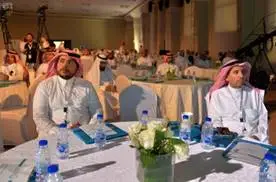
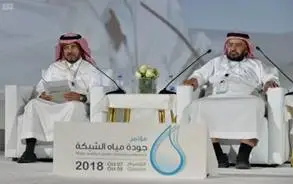
The Network Water Quality Conference continued its activities today, at the King Khalid Cultural Center in Buraidah, where three dialogue sessions were held that included 8 working papers.
The first session, chaired by the Vice President of Qassim University for Graduate Studies and Scientific Research, Dr. Ahmed Al-Turki, discussed three working papers on the first of which came under the title "Quality of groundwater" by Dr. Hussein Al-Ajmi Groundwater, where he explained that it constitutes approximately 98% of fresh water and constitutes almost 60% of the sources of drinking water supply projects in the Kingdom, while the second paper was entitled "Plastic pipes used for drinking water in networks and homes" in which Engineer Turki Al-Shahrani talked about the advantages of plastic pipes and that they are environmentally friendly, while Dr. Ahmed Al-Arifi presented the third paper entitled "Desalination Industry in the Kingdom of Saudi Arabia" in which he touched on the water challenges facing the Kingdom and the history of the desalination industry and some statistics locally and globally.
The second session, chaired by the Director General of the Water Regulation Department at the Ministry, Dr. Abdulaziz Al-Shuaibi, discussed three working papers, the first of which dealt with "Promising desalination methods" presented by Dr. Ibrahim Al-Mutaz, in which he explained that there are techniques still in the process of experimentation such as desalination by the process of humidification, dehumidification, desalination by freezing method and others, and the second paper discussed the topic of "Optimal design of water purification plants to reduce waste from wastewater" by Dr. Mohammed Heikal, in which he explained that water purification plants produce daily quantities of The third paper was entitled "Specifications of transported water and its impact on the shelf life of transport systems and their reflection on the quality of water arriving to the consumer" presented by Dr. Saud bin Murshid, in which he highlighted the operational technical specifications applied to the transport systems of sweet water in the Kingdom.
The third session, chaired by Dr. Bader Al-Baridi, former Director of Studies and Designs Department at the General Directorate of Water in Qassim, dealt with two working papers, the first of which discussed the topic of "Protection of buried carbon iron pipes used in the transport of water from corrosion", in which Eng. Hamad Ababtain spoke about the importance of protecting carbon iron pipes because it is the nerve of the project to continue serving as long as possible, while the second and last paper in this session was presented by Dr. Ali Al-Hamza entitled "Monitoring of organic and inorganic pollutants in the water produced." From the plants of the Saline Water Desalination Corporation" in which he pointed out that the World Health Organization's standard specifications for drinking water showed the results that organic and inorganic pollutants in the water produced from desalination plants are within the limits allowed by the World Health Organization.
Searching for sustainable solutions for Saudi Arabia
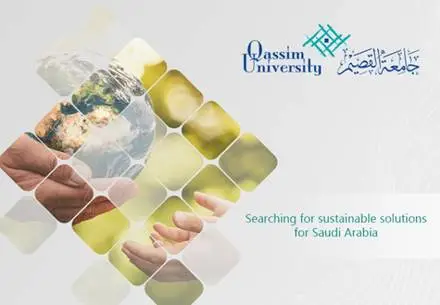
Researchers at Qassim University are using the latest technologies to find sustainable power sources and environmentally friendly water management techniques
From turning date palm tree waste into renewable energy to harnessing the power of the sun, Qassim University is on a mission to find sustainable power solutions.
Investigating sustainable developments in energy, water and environmental engineering is one of the university's 10 priorities, set out in its 2020 to 2024 research strategy.
Sustainable technologies are crucial in Saudi Arabia, where wastewater, municipal and construction waste and air pollution pose environmental threats. The Saudi Vision 2030 has set a target to power half the country with renewable resources by 2030.
Qassim University is working on a host of solutions, from sludge management and waste recycling to sea and groundwater desalination.
One notable project, led by Professor Sulaiman Alyahya, is examining how this waste from date palm trees can be transformed into renewable energy.
The central Al-Qassim province has more than 8 million date palm trees. The trees produce a large amount of agricultural waste including dry leaves, stems and seeds. "A quarter of the date palm is waste and many of the farmers burn that waste, which of course produces CO2 emissions and harms the environment," says Alyahya. "We are really concentrating on how to convert this waste to energy."
An international group of researchers, including scientists from Iowa State University, is investigating how the latest technologies can turn the waste into renewable energy forms like biomass, bio-oil and biogas.
The researchers are using the new technique of autothermal pyrolysis, developed by Iowa State University's Bioeconomy Institute. The process is simpler and cheaper than conventional pyrolysis and does not require an external energy source.
"If we achieve this goal to convert the waste of date palms into energy, Saudi Arabia will have a reduction of almost 8,000 tonnes of CO2 emissions," says Alyahya. "We will stop burning the waste of agriculture and at the same time create richer products."
Solar power research is another focus for Qassim University. Dr. Muhannad Alaraj, an assistant professor in the university's Department of Electrical Engineering, is exploring how photovoltaic panels can transform light into power.
"We are investigating the economic effectiveness of PV panels in the Al-Qassim region. We're also studying the effect and forecasting for those PV panels and we currently have a small PV system from which we are collecting the data," says Alaraj.
"We have to consider the weather conditions and meteorological parameters. This is really important because in our region we have mostly sunny days, but sometimes there are sandstorms or clouds. We are trying to see the effect of this weather on PV panels. This will be really helpful to build a model to predict or estimate how much power or energy we will get from this PV panel each day."
As one of the world's most water-scarce nations, Saudi Arabia also needs innovative ideas for renewable water sources.
Dr Saleem AlSaleem, from the College of Engineering, is working on water and wastewater treatment, such as as greywater treatment and using solar energy to treat saline water. His team is also developing solutions for solid waste management and tackling noise pollution.
AlSaleem is a member of the university's Sustainable Development Center, which oversees Qassim's progress in its sustainability initiatives. The center runs four greening projects, focusing on the curriculum, the campus, research and the university as an organization.
AlSaleem and his colleagues say collaborating within and outside the university is important for a successful research project. Qassim's scientific research deanship has launched a number of international collaboration grants and encourages faculty members to apply. "We can improve our work by encouraging collaboration," says AlSaleem. "I am working with water companies and municipalities inside Saudi Arabia, and we also collaborate with researchers outside the country. For example, I am working with one professor in Malaysia and another in Italy."
The university's future research into sustainable developments will be boosted by a recently announced research chair for artificial intelligence. The chair will fund studies into AI across the university, including in agriculture and engineering.
"I'm currently working with five teams to see the role artificial intelligence can play in agriculture and renewable energy," says Alyahya.
The Governor of the Qassim Region lays the foundation stone for the first phase of the Buraydah Green Oasis project
His Royal Highness inaugurated The Emiri Dr. Faisal bin Mishaal bin Saud bin Abdelaziz Amri District Qassim, The Green Oasis Project. In the city of Buraidah, a stone was laid the basis for the first phase of the project. At a cost of more than 77 million riyals, With a total area of 28 million. A square passed, and 200 thousand were planted Tree, implemented by the Ministry of Environment Water and Agriculture in cooperation with the Amana area. The Buraydah Oasis Project and the likes of these are giant water projects that the Ministry of Environment and Water is working on it. And agriculture for the renaissance and development of the process environmental sanitation, and work on all that matters is the glory and honor of the homeland and the citizen, what you get By His Highness Amir Al-Qassim, supported by From His Excellency the Minister of Environment, Water and Agriculture.
The Department of Plant Production and Prevention held a symposium on sustainable agriculture on 27/2/2019 entitled (Sustainable Agriculture: A Safe Product and a Clean Environment)
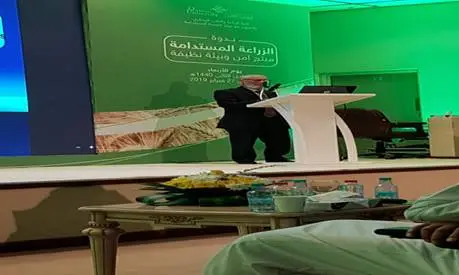
A number of college students visit the protected agriculture course to the hydroponics project in Anizah.

On Monday, 2/3/1439, a number of students of the Faculty of Agriculture and Veterinary Medicine Department of Plant Production and Prevention within the course of protected agriculture paid a scientific visit to the headquarters of the hydroponics project of the Directorate of Agriculture in Onaiza and the delegation received Engineer Abdulmohsen Al-Harbi, supervisor of the project, where he accompanied him to visit the project and gave a full explanation about hydroponics and its importance to the conditions of the Kingdom and answered all the questions and inquiries of the students after that accompanied us on a visit to Engineer Abdulrahman Al-Maiman, who manufactures, establishes and installs materials and devices Hydroponics. This impressed the students with what they saw which increased their understanding of the material and their love for this method of agriculture. This scientific trip was supervised by Dr. Abdulrahman bin Mohammed Al-Mashileh.
The Green KSA Initiative
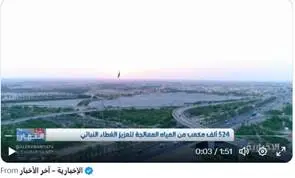
Within the # Saudi Arabia_Green initiative and to achieve the goals of the Kingdom's Vision 2030.
# University_contributes to increasing the vegetation area within the university city and benefiting from approximately 524 thousand cubic meters of treated water to reduce the effects of desertification
Student's engagement in activities and community services about sustainability and climate change.
Main Initiatives:
- Increasing involvement of students in activities related to sustainability and climate change. Key Performance Indicators:
- The Number of student organizations related to sustainability (includes climate change).
- Number of cultural activities on campus (e.g. Cultural Festival) including virtual activities involving sustainability concepts (includes climate change).
- Number of organized community services to tackle the sustainability and climate change concepts.
Our environment is our life... we do not destroy it with our own hands. Be responsible and protect the environment.
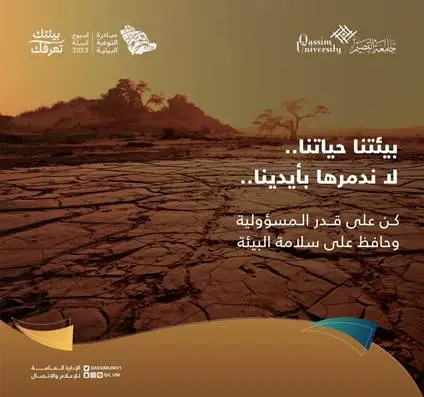
References
[1] [Online]. Available: . https://www.qu.edu.sa/content/news/2457.
[2] [Online]. Available: .https://www.spa.gov.sa/1823762
[3] [Online]. Available: . https://www.timeshighereducation.com/hub/p/searching-sustainable-solutions-saudi-arabia
[4] [Online]. Available: . https://qu.edu.sa/files/shares/newspaper/105/105.pdf.
[5] [Online]. Available: .https://cavm.qu.edu.sa/content/news/1336.
[6] [Online]. Available: .https://cavm.qu.edu.sa/content/news/396.
[7] [Online]. Available: .https://twitter.com/QassimUniv1/status/1670478362530181120.
[8] [Online]. Available: .https://pdq.qu.edu.sa
[9] [Online]. Available: .https://twitter.com/QassimUniv1/status/1635948481301839872
